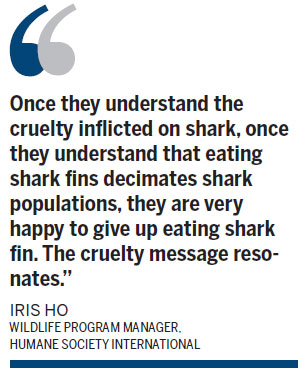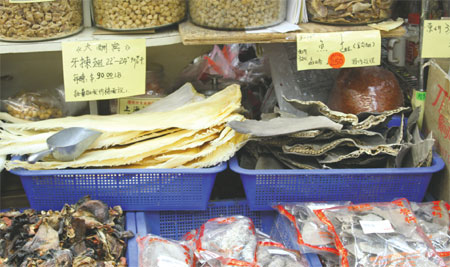Status symbol loses its NY status
Updated: 2014-06-27 11:01
By Amy He (China Daily USA)
|
||||||||
New York is one of the biggest markets for shark fins outside of Asia, but that will change to "New York was" on July 1 when a ban against the possession, sale and distribution of shark fins take effect, AMY HE reports from New York.
When Chinese get married, shark fin soup often is on the banquet menu, traditionally paid for by the groom's family. It's such a status symbol that the saying goes that a bride marrying into a family who can't provide shark fin soup is marrying into a poor one.
But starting on July 1 that banquet table - or a table at any restaurant - in New York that has shark fin soup on it will be violating the law that Governor Andrew Cuomo signed, banning the possession, sale and distribution of shark fins.
Violators will be fined $100 per fin in possession and may face up to 15 days in jail as New York becomes the eighth state to ban the trade of shark fin, joining Hawaii, Washington, Oregon, California, Maryland, Delaware and Illinois.
As the July 1 date approached, stores in Manhattan's Chinatown that sell other Chinese delicacies such as swallow's nest and abalone, were rushing to get rid of their stock of shark fin. On the Po Wing Hung storefront on Elizabeth Street signs indicated that all shark fins were being deeply discounted. Customers buying more than half a pound of swallow's nest were getting a free package of shark fin, read one sign.
Other specialty stores like Yue Fung USA Enterprise were offering similar discounts, with many shark fin types selling for 50 percent off. One type of fin originally priced at $168 a pound was down to $128 a pound and that would drop to $100 a pound if a customer wanted more.
"Everything has to go, so we would be happy to give people a good price if they're looking to buy," said the salesman, who declined to give his name. And everything - shark fins, that is - appeared to be going. Sales people at multiple Yue Fung USA Enterprise locations in Chinatown said their stores had little stock remaining because customers knew about the July 1 date.
Stocking up
A sales person at Po Wing Hung said that many people were looking to stock up.
"There was just this one woman who came and bought two big packages of it," said the sales person who declined to give his name. "Who said nobody is buying?"
New York is one of the biggest markets for shark fins outside of Asia, and it became the largest port of entry for shark fins in the US after California enacted its ban. It is also home to the largest US Chinese population that uses shark fin in soup.
The shark fin industry generates about $400 million to $550 million a year, according to the Pew Environment Group, though like many other industry-related figures, they are only estimates. It's difficult to monitor shark-finning activity, and many statistics are anecdotal.
Some estimates show that 73 million sharks are killed yearly for their fins, and 80 to 90 percent of the global shark population has declined due to finning. Meanwhile, the value of shark fins has increased as the Asian economy grows, and particularly as China becomes wealthier. Shark fins can cost from $30 to $800 per pound, and a bowl of shark fin soup can cost upwards of $100 at some Chinese restaurants.
When the ban goes into effect, New York restaurants will no longer be allowed to sell the dish, and restaurants that merely have it on their menus - even if they don't serve it - can be fined, according to the Humane Society International.
A recent China Daily check of 10 Chinese restaurants in Manhattan's Chinatown found only one still had shark fin soup on its menu, with workers at many of the restaurants saying that with the ban so close they had to change their menus.

Congee Restaurant's menu still listed it - $15 for a single serving of shark fin soup with chicken and crabmeat; $68 for four servings of a soup made with a higher grade fin. A worker said that with the ban fast approaching, the menu also will be changed.
"There are still people who want the soup, but what are we going to do? If they're not going to let you sell it, then you have to comply. The fines you get you can't earn back from selling the soup," said the worker, who declined to give his name.
The ban was signed into law last July and gave merchants one year to phase out their stock. Beyond the sales to individual customers, some merchants are selling what they have to buyers in other states that don't have a ban, said Patrick Kwan, communications director at Chinatown Partnership, who was formerly New York director at the Humane Society.
"The entire West Coast has banned shark fin, so when California and Hawaii and Washington state banned the fins, a lot of the fins went to Illinois and New York," Kwan said. "There was news that some of the restaurants were selling it to buyers in Connecticut."
New York's shark fin ban is a huge step in reducing overall consumption in the US, particularly after the California ban went into effect in July 2013, said Jamie Pang, legal fellow at the Animal Welfare Institute (AWI).
"Because New York and California are the biggest states [that have this ban], we do believe it will have a sizable market difference because of the size of the market, and because it sets a good example for the other states if the two largest states that were importing it did enact a ban," she told China Daily.
Since New York has been a shark-fin source for merchants from other states, demand along the East Coast will probably decline as a result of the ban, Pang said.
The Empire State has the highest number of Chinese restaurants with shark fin soup on their menus, according to a database compiled by the AWI. Shark fin consumption is mostly concentrated along the US coasts with their larger Chinese populations, and there are more than 60 Chinese restaurants in New York that serve the dish, compared to, for example, five in Kansas.
Though those in New York who want shark fin soup after July 1 won't have a very hard time getting it in neighboring states that don't have a ban - such as Pennsylvania, New Jersey and Connecticut - the newer generation of Chinese and Chinese Americans have become less interested in the dish over time, according to Kwan.
For restaurants, shark fin soup is a low-profit-margin dish because the ingredients are so expensive, Kwan said. For Chinese, shark fin as a status symbol makes buying and consuming the dish a burden too, he said.
"When we do outreach, the older folks are like, 'I can't wait for you to ban the fins because I don't want to feel the pressure of serving it'. It's kind of one of those things were Mrs. Chen's daughter's daughter had 10-inch fins and they feel like they need a bigger fin, or a fancier thing. I've always said, the dish is really a status symbol and a 'Keeping Up With the Joneses' sort of fish, so people feel the obligation to serve it," he said.
But for many Asians - particularly in China - shark fin is still an ultimate status marker.
For almost a millennium shark fin has been one of the ultimate culinary delicacies in China. Dating back to the Ming Dynasty in the 14th century, shark fin has consumed in soup form. Shark fin made up such a small portion of a shark that it was a precious food only the emperor had the privilege to consume.
As a food meant for the wealthy, it fell out of favor after the founding of PRC in 1949 when shark fin was a symbol of conspicuous consumption. After Deng Xiaoping opened up the country, instituted reforms, and the Chinese economy took off, shark fin consumption became mainstream again. It has since become a traditional part of dinner parties and banquets, with the Chinese consuming the most shark fin from October to February, when weddings are held and holidays fall.
Awareness campaigns
While China still consumes the biggest portion of shark fin worldwide, animal interest groups and the government have sought to educate people about how sharks are killed for their fins, causing shark-fin consumption to steadily decrease.
The Chinese government announced that it would ban shark fin soup from government banquets by 2015, which the Hong Kong government has done. As part of a bigger takedown of corruption under the new administration, the Chinese government also banned luxurious banquets altogether, which has impacted high-priced luxury goods and foods usually given or consumed at these banquets.
In 2006, former NBA player Yao Ming, actor Jackie Chan and film director Ang Lee were part of social awareness campaigns against shark fin consumption.
"As soon as people realize that what their consumption of shark fin has an impact on the animals, most of them voluntarily push to not eat shark fin again. It's about public education, it's about getting the message out, it's about reaching as many people as possible," said Iris Ho, wildlife program manager at the Humane Society International.
"Once they understand the cruelty inflicted on sharks, once they understand that eating shark fins decimates shark populations, they are very happy to give up eating shark fin. The cruelty message resonates."
Demand in mainland China is still much stronger than within the Chinese communities in the US, but China has made tremendous strides in its anti-shark-finning efforts, Ho said.
"If you're comparing the Chinese community here in the US and Chinese mainlanders community, obviously people here in the US have less interest in consuming shark fins than people in China. After all, that's why China is the largest market for shark fins," she said. "But there has been tremendous progress in China as well."
Shark finning is the practice of removing just the fins from sharks and then discarding the fish back into the ocean, where the sharks can no longer swim or pass water through their gills, and die from suffocation or blood loss.
Because many kinds of sharks from where the most valuable fins are cut are big and heavy, keeping shark bodies on often small-sized vessels after they are finned is not economically viable. There is a market for shark meat, but demand has been relatively static and the profit isn't nearly as high as with fins, according to the National Marine Fisheries Service. So hunters fin the sharks while they are still alive and then throw the animals back into the sea.
"By keeping only the fins, fishing vessels can take more sharks on a single voyage, making the hunting ruthlessly efficient and increasing the likelihood of draining the oceans of sharks," AWI wrote in a brochure about sharks at risk. Many sharks are also caught accidentally as "bycatch" and are finned "opportunistically", AWI noted.
The depleting shark population is of concern to scientists since sharks occupy the top of the food chain and are known as a "keystones" species, meaning that shark extinction would lead to the collapse of an ocean's entire ecosystem. Sharks are apex predators, keeping other prey species in check, eating sick and old fish, generally keeping ocean populations healthy.
"When shark populations decrease, a ripple effect can spread throughout the rest of the ecosystem," said the Smithsonian Institution on its website. The loss of a certain type of shark can lead to the increase of other animals, which may deplete the populations of other species, hurting biodiversity and harming human fisheries, the institution wrote.
It's difficult to revive shark populations when they decline since it takes almost 20 years for sharks to reach sexual maturity. Once they do, their gestation periods last up to two years, and unlike other fish, sharks give live birth to a handful of young instead of a large number of eggs.
"Some shark populations have declined by as much as 90 percent and some shark fisheries that collapsed in the first half of last century still have not recovered," AWI wrote.
Though people are becoming more aware of shark conservation efforts, discussion and concern over the depleting shark population have not been as rampant as that for other endangered species, like the panda or humpback whale.
And that is because sharks have long had a bad public image as people killers. But statistics show that between 2006 and 2010 in the US, there were only 179 shark attacks in the entire country, three of them fatal. Drowning fatalities occur at a rate of 1 in 3.5 million in the US compared to the 0 in 264.1 million for shark attack fatalities, according to the ocean conservation group Oceana.
"The real threat is humans. For every human killed by a shark, there are approximately 25 million sharks killed by humans," the Washington-based group said on its website.
Fin alternatives
Environmentalists and activists say sharks are worth much more alive than dead. Ecotourism involving sharks, where people pay to visit areas with shark populations or take part in diving expeditions with sharks, is worth an estimated $47.5 million worldwide, said the AWI. Shark-watching and recreational diving are increasingly popular, "creating a strong incentive for local communities to protect their shark populations", it said.
People in New York, like those in other states with a shark-fin ban, still have options for shark-fin alternatives. Man-made shark fin, often called faux shark fin or artificial shark fin, is gaining popularity. Faux shark fin can be made in a variety of ways, with some companies using seaweed or vermicelli. Others, like chef Corey Lee of San Francisco's Benu Restaurant makes his own version of shark fin soup by treating broth with hydrocolloids, hydrophilic polymers that give liquids texture.
Some anticipate that banning shark fin is going to encourage underground trade in New York, just like in California, where enforcement of the ban has been difficult, according to the Wall Street Journal.
"In California, it was a very controversial issue. Community groups sued over the constitutionality of it and we have seen the majority of underground trading is happening in San Francisco because they just don't agree with the ban," AWI's Pang said.
But depending on the attitudes and stock remaining in New York, things could vary, Pang said. When asked about where unsold shark fin will go when the ban starts, one shop owner at a Chinatown store said "there are places [the fins] can go", without giving any details.
Others like Kwan said that he doesn't anticipate there will be a lot of underground trading, because cooking shark fin at home is difficult.
"It's one of those things where you have to have specialized training, somewhat - how to dry it and things like that. Being that it's an expensive ingredient, you don't really want to mess up. We're not talking about baking a cake," he said.
Now that it will soon be illegal to trade it, there will be even less of an incentive to pursue it through other means, said Kwan.
"People use it during banquets and weddings because they want to be able to - for lack of a better term - show off. So if it's illegal to do so and you can't show off, what's the point of it? Why go through the trouble of getting fined $100 for each fin and spending 15 days in jail for a soup that doesn't even depend on the fin for its taste? It's not the soup that's illegal, it's the fin. You can still make the soup."
Contact the writer at amyhe@chinadailyusa.com
|
Shark fin on sale at a New York Chinatown supermarket. Markets and dried-good stores that still have shark fin are in a rush to deplete their stock before a July 1 ban on shark fins takes effect. Photos by Amy He / China Daily |
|
Shark fin sale signs outside a supermarket. The yellow signs say that customers who buy half a pound or more of swallow's nest will be given shark fin for free. |
(China Daily USA 06/27/2014 page20)

 Bridging the culture gap
Bridging the culture gap
 Consumers from China prefer niche luxury items
Consumers from China prefer niche luxury items
 US president shares nation's World Cup agony
US president shares nation's World Cup agony
 China navy is RIMPAC 'highlight'
China navy is RIMPAC 'highlight'
 US hopes high for S&ED
US hopes high for S&ED
 Move to domestic software pressures foreign companies
Move to domestic software pressures foreign companies
 Culture camp delivers authentic China
Culture camp delivers authentic China
 Ancient Chinese folktale returns to New York City
Ancient Chinese folktale returns to New York City
Most Viewed
Editor's Picks

|

|

|

|

|

|
Today's Top News
China's presence in RIMPAC 'significant'
US hopes high for S&ED
Restrictions loosened in Shanghai trade zone
Top-level general expelled for graft
Job ads signal Apple plans for retail expansion
China says no evidence of pet link
US sends 300 more troops to Iraq
Palace Museum feeling the squeeze of visitors
US Weekly

|

|








